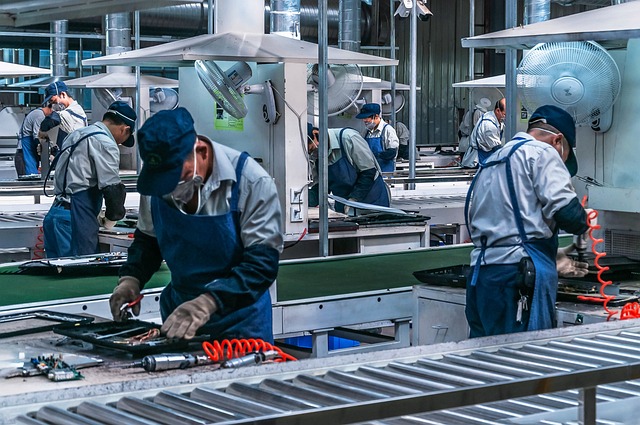Hungary doomed to be the assembly line of Europe?

With its affordable workforce, Hungary attracts international companies, yet while assembly plants provide jobs for Hungarians, the country may not reap significant benefits from these setups.
Pénzcentrum analysed 2023 macroeconomic data published by Eurostat, arguing that Hungary has become the “assembly country” of Europe.
Looking at hourly labour costs within the European Union, and more narrowly, the Eurozone, we see that since 2022, there has been a steep rise in wages. In the EU, the average hourly labour cost rose from 30.2 euros in 2022 to 31.8 euros last year. For Eurozone countries, these figures were 34 EUR in 2022 and 35.6 euros last year.
Hourly average labour costs in the industry sector vary significantly across different fields. Therefore, Eurostat detailed different industries. For instance, in the EU, labour costs in construction averaged 28.5 euros, whereas in services, they soared to EUR 31.8.
Hungarian workforce costs a fraction compared to other EU nations
A further complication in calculating average labour costs is the substantial price discrepancies across the continent. For instance, Luxembourg, with the highest average hourly labour cost, stands at 53.9 euros. Second and third, perhaps unsurprisingly, are Denmark and Belgium with costs over 47 euros.
It is in this context that Hungary stands out within the EU, albeit for the wrong reasons. Hungary ranks as the third cheapest nation in terms of hourly labour costs, at 12.8 EUR. Only Romania, where workers earn an average of 11 euros per hour, and Bulgaria, with 9.3 euros, have lower costs.
Low wages attract assembly plants but indicate a fragile economy
As Pénzcentrum highlights, lower labour costs make the country appealing to international corporations. These figures show that in Hungary, employees are willing to accept lower wages, given the relatively lower income levels in the country compared to other EU nations. Consequently, these lower costs translate to cheaper overall production, resulting in increased profit margins for companies.
The relatively weak Hungarian salaries are further evidenced by another statistic we covered last month: Romania has outpaced Hungary in GDP based on purchasing power standards for the first time. This implies that Romanians can afford more with their salaries than Hungarians can with theirs. Overall, Hungarian GDP per capita was the 6th lowest in the EU in 2023, standing at 76 percent of the Union average.
Assembly lines offer employment, yet pose long-term economic risks
Assembly lines in factories provide jobs for many in the countryside, Telex reported in 2022. They wrote about how according to data gathered two years prior, 1.9 percent of men, and around 3 percent of women worked at assembly lines in the country. In 170 towns over 10 percent of the population was employed as assemblers. In certain regions of Hungary, these jobs, usually having to do with car manufacturing or battery production, are invaluable.
Assembly lines in factories provide employment opportunities for many, particularly in rural areas, as reported by Telex in 2022. According to data gathered two years prior, approximately 1.9 percent of men and around 3 percent of women worked at assembly lines in Hungary. In 170 towns, over 10 percent of the population was employed in assembly roles. In certain regions of Hungary, these jobs, usually having to do with car manufacturing or battery production, are invaluable.
However, the news outlet highlights that an economic model centred on assembly plants, characterised by low added value, may be unsustainable in the long term. With robotisation on the rise, the stability of these positions is precarious, and mass layoffs during modernisations can lead to economic instability.
In recent months, the issue of battery manufacturing has been a political minefield, with the government supporting the expansion of multinational companies into the country. Read our coverage of the issue here: Hungary becoming a battery superpower: is it a good idea?
Read also:
- Europe’s lowest tax rates a big attraction for foreign firms in Hungary, says minister in Bangkok
- Giant Chinese battery plant in Hungary launches active recruitment
Get our daily news collection, sign up and subscribe your friends to our newsletter here
Source: Pénzcentrum, Telex


Most multinationals will operate their plants as “contract” or “consignment” manufacturing. Leave as little margin in the country as your transfer pricing study and risk appetite will allow and coupled with low wages – voila! Corporate paradise.
Another “item” is environment, health and safety in Hungary. We have higher rate of work related injuries, deaths and diseases – however first of all you will not have the authorities bouncing all over your site in our country (as opposed to some – so bank on under-reporting in Hungary), and secondly, if someone loses an arm, contracts a lung disease, dies etc. the associated cost is significantly lower. So you can afford to have your workers be exposed to a little more risk in the workplace, and if something goes sideways, a company just pays the appropriate amount and plods on. Expendable?
Did not mention environment – however I believe none of us are under any illusions…
Low productivity and low educational attainment inevitably lead to the continued creation of low-wage workers. Society needs to put a little more effort into education.
So better have no jobs lol what a joke as article. Journalism is the new comedy